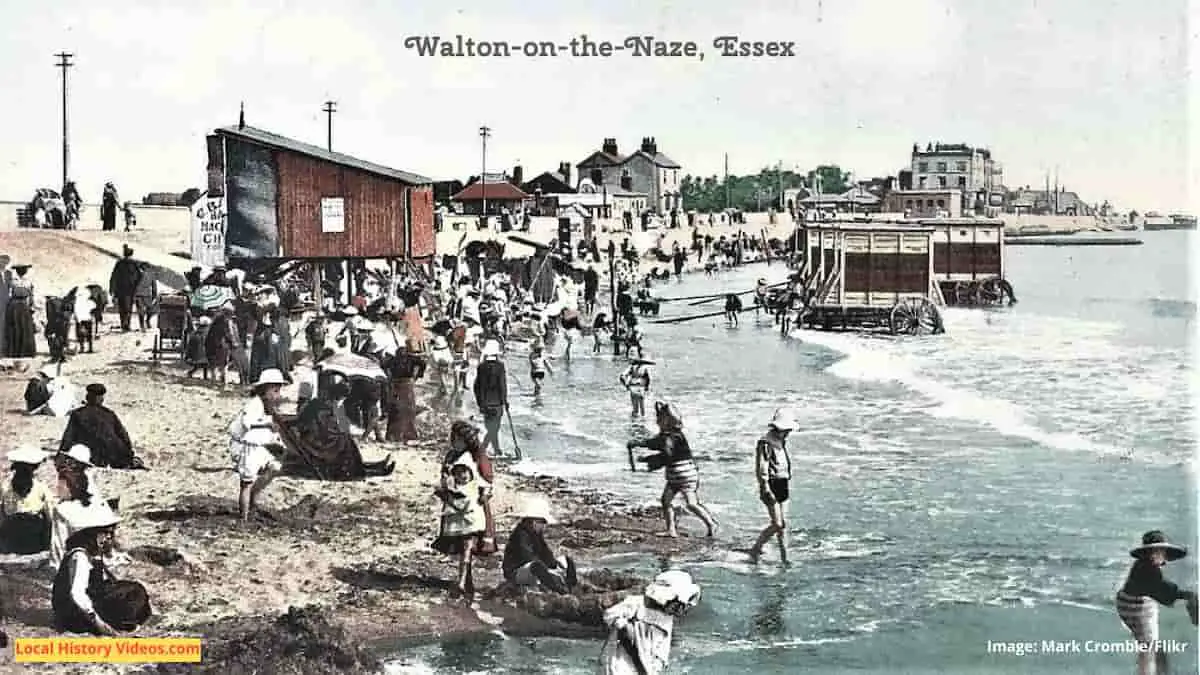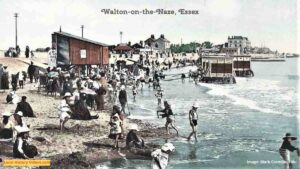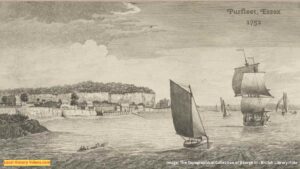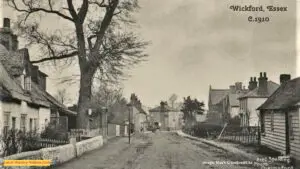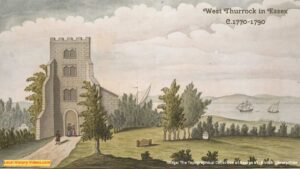Glimpse history through old images of Walton-on-the-Naze, Essex, England.
Cliff Houses 1931
In 1931, a cliff fall damaged the foundations of one of Walton-on-the-Naze’s lovely cliff top homes.
As the angle of the camera moves, we can see a number of other homes along the road. There’s also a shot of a house further back in the other direction.
SUBSIDENCE: Houses damaged by cliff falls at Walton-on-Naze (1931) – British Pathé on YouTube
School Film Unit 1962
In 1962, the local county secondary school ran a film unit for its pupils.
This newsreel includes pupils, teachers, classrooms and the woodworking room, the dressmaking room, the art class, and the beach.
Mr L. F. Broom, who created the programme, the teachers who engaged with it, and the school who provided the expensive resources to support it, are here celebrated for the great work they were doing to raise pupil engagement, expectations and employability.
School Film Unit (1962) – British Pathé on YouTube
Walton-on-the-Naze 1983
In 1983, the population of Walton-on-the-Naze was 5,664. It would double each summer as holidaymakers arrived, some of them returning every year for decades on end.
Dancing on the pier had given way to yoga and jogging, but roundabout rides and playing on the beach were still a core part of the family fun here.
Some of the local workers arrived for the summer season too, including young Barry the Londoner who pestered the girls as part of his job on the dodgems.
Taffie Reece, a former science teacher, took a semi-retirement job as chief beach inspector. He couldn’t swim.
A family company provided the local outdoor cowboy show.
Just Another Day Walton on the Naze Part 1 – British Pathé on YouTube
In part 2, we learn that the lifeboat crew have their nights and romantic evenings interrupted by call outs.
Meanwhile Jimmy Andrews, a former clown, entertained customers on the Twister by eating lit cigarettes.
It was £1 for a toy penguin. (At the time, that was roughly an hour’s pay for a supermarket cashier).
There’s music and dancing at the Martello Club, along with some attempts at singing. The interview with the musicians raises a smile. They perform 6 nights a week for 18 weeks.
The next conversation is with Barry at the Dodgems, which is hilarious – even though it’s discussing the injury list.
Just Another Day Walton on the Naze Part 2 – British Pathé on YouTube
Historic Book
Extract from:
An historical and geographical description of … Walton on the Naze, etc
Published in 1840
Pages 12 – 15
The sea has made great devastation on this part of the coast for a long period, and still continues to wash away the soil, though not so much as formerly, (if we except a part of the coast opposite the Terrace, for a new wall erected here about three years ago, is now completely destroyed,) the ancient village is entirely vanished with the exception of five or six old cottages which stood inland, and which the sea has not been able to reach.
Upwards of one hundred years ago the sea first began its inroads on the village, and house after house gradually disappeared in the devouring element; it soon reached the church, when it was melancholy to see the remnants of half-decayed coffins protruding through the soil. The sacred fabric gradually vanished, and in a little time the whole village was swallowed up in the mighty waters, except the cottages before mentioned.
The distance from the present shore to the ancient one is upwards of a quarter of a mile; but the bottom of the sea is very shallow as far as the old village reached, and at low water is nearly dry for some distance; the earth which has been washed down from the cliffs has been carried out to sea and turned, by the action of the salt water, into a hard blackish substance resembling cement.
The endowment, or corps of one of the prebends of St. Paul’s Cathedral having been swallowed up long ago, is styled prebenda consumpta per mare, it had the thirteenth stall on the left side of the choir, and was rated at one mark.
King Edward the sixth granted to Sir Thomas Darcy, the manors of Thorpe, Kirby, and Walton, and the advowson of the vicarages, with their singular privileges, their immunities have descended to the Right Hon. the Earl of Rochford, and from him to the present owner, no bailiff can arrest any person in these sokens, except the Lord’s bailiff, (by the ancient custom,).
The custom as to lands are peculiar, they are mostly copyhold but nearly as good as free, first they pay twelvepence an acre for a fine, and two shillings for a cottage. Secondly, they may pull their houses down without a licence. Thirdly, they may cut down their young trees. Fourthly, they may grant a lease even for fifty years, and do most things contrary to the customs of other places.
Walton is a corruption of Wall-town, which was so named from a wall of earth which was formerly thrown up here to repel the encroachment of the Sea. It is sometimes called Walton le-soken; now soken is derived from the Saxon Soc, or Soca, signifying a peculiar power or liberty, but it is more frequently called Walton on-the-naze; this is derived from the Saxon word nose, signifying a neck of land, as a river running from the Harwich coast, separates Walton from the mainland and approaches within a short distance from the sea, rendering the place quite a peninsula, the river is navigable for vessels of large tonnage for a considerable distance; and corn lighters, colliers, and other small craft, ascend as high as the water mill, where there is a quay, here is a small island in this river called Pewit-island, from a great quantity of birds, of that name, who frequent the place, the river flows a considerable distance further inland encircling a large island called Horse-island, which is passable at low water on foot, the sportsman may here pursue his pleasures, from the different sorts of wild fowl, and other game which frequent the shores of the river and islands above named.
” The surge most swoln that met him: his bold head
‘ Bove the contentious waves he kept, and oar’d
Himself with his good arms in lusty stroke
To th ‘ shore, that o’er his wave – worn basisbow’d.”
The Tempest .
Walton is far superior to a number of places of a similar kind, in having a beautiful natural beach, composed of a fine sand, which is nevertheless firm and durable; and on it numbers may be seen promenading on a fine day.
Invalids will find it very beneficial to rise early and take a stroll along the beach, and enjoy the cool invigorating air which blows with double freshness from the water.
Pages 16 – 20
The entrance to Walton is from the northwest, which is the only one in the place. Passing over a causeway, which crosses a low marshy point, where the river terminates; the first object that arrests attention is the church, which stands on the right-hand side of the road.
After the old one was washed away, a small one was built here with red bricks, but since the increase of the inhabitants has been so great within the last few years, it was found not large enough for their proper accommodation. It has been, therefore, considerably enlarged; a new steeple built, and a piece added to each end of it. The inside is fitted up in a very chaste manner; on each side are five arched windows fronting each other, all of one uniform size and structure. A gallery has been built at the west end; the entrance to the church is on each side of the steeple. It contains only one bell, the roof is covered with slate, and it has altogether a very neat appearance.
The first street you enter is called High Street.
The first Inn in the place, as you enter, is called the Porto-Bello; it is a lofty, commodious house, which has been recently rebuilt of red brick, in a much more elegant manner than formerly. It is kept by Mr. Palmer.
Opposite this house, a lane leads down to the quay and water-mill; and likewise to the Martello tower, which stands on the left of the road, about a quarter of a mile from the principal street. This is one of those fortifications that were built by the government during the last war, for the protection of our coast; it is nearly an oval in shape, gradually receding in size from the base. It is about thirty feet in height from the ground, built with brimstone-coloured bricks, the copings and archings of the windows, doors, staircase, etc., are all of stone. You ascend by a small ladder on the western side, when you enter a fine vaulted apartment, the width of the entire tower, with a pillar of brick in the centre to support the ponderous roof. A large dungeon or keep runs under this room; there is a staircase on each side of the tower, which leads to the top. This is paved with freestone in large squares, a battlement round the side about six feet high, around the inside of which is a platform, by means of which a company of soldiers could mount and discharge a shower of musketry upon the assailants beneath. Three iron posts are fixed in the middle of the roof, on which the guns work, but there are none kept here at present; it is kept by a man who receives a salary from the government, who keeps it clean and in order. In front of this, facing the sea, is a half-moon battery, carrying three guns.
Retracing our steps to the inn, we turn up a road which leads to the Marine Hotel, past a handsome row of white-brick buildings, called Sidmouth Terrace; at the end of these, a lane leads to the right, called Newgate Lane, from a traditional report that malefactors used to be executed here in former times, this leads to the Marine Villa, and to the site of the old tower, similar to the one just mentioned, with the exception of having a moat and no battery attached to it; this tower has been lately sold and is now pulled down, and the site will, in a short time, no doubt, be converted into allotments for the purpose of building.
Leaving the above, we pass by a new building, recently erected for a Bazaar of fancy goods, it is kept by Miss Gilson.
Close to this stands another large edifice, with a portico in front, of the Grecian order of architecture. Part of this is devoted to a Bazaar, kept by Mr. Woolstone; the other wing is a Billiard Room belonging to the Hotel, as are also the upper apartments, which are formed into some handsome Reading Rooms – a handsome clock has been lately fixed on the front, over the principal entrance opposite the Hotel.
The Marine Hotel is a fine commodious building, with a portal over the principal entrance of stone in the rustic order. A passage leads from this to the opposite extremity of the building, from which numerous rooms branch on each side, fitted up with every comfort and convenience that is necessary for the comfort of the visitors, who are of the first respectability. It is built in the form of a double square, the principal apartments with the servants’ offices, etc., being situated in one, and the Tap, Stables, coach-houses, etc., in the next, behind. It is kept by Mr. Kent.
Opposite the Hotel is the Jetty, a handsome structure stretching a distance of two hundred feet into the sea. It is built on piles and formed with wood as high as the platform. The boards you walk on are placed transversely on joists, and an aperture is left about two inches wide between each board to facilitate the discharge of the water, which during the winter season frequently washes over the top, and which likewise keeps it clean. A beautiful railing runs around the whole formed of cast iron posts and forged bars, painted green, with a rail of wood surmounting the whole, of a stone color.
At the further end are two convenient stairs for the landing of passengers and goods, every person must pay one penny to a man stationed at the entrance who wishes to go upon it, towards defraying the expense of its erection and repairs – one payment suffices for the day; several large chairs are placed upon it for the convenience of the public, where you may sit and have a charming view of the German Ocean, and likewise of the whole length of the village, which is particularly pleasant on a hot day.
There is something very sublime in the appearance of the scene by moonlight on a fine summer’s night when not a sound is heard, save the gentle rippling of the waters under your feet, or the dash of some distant oar sounding on your ear.

